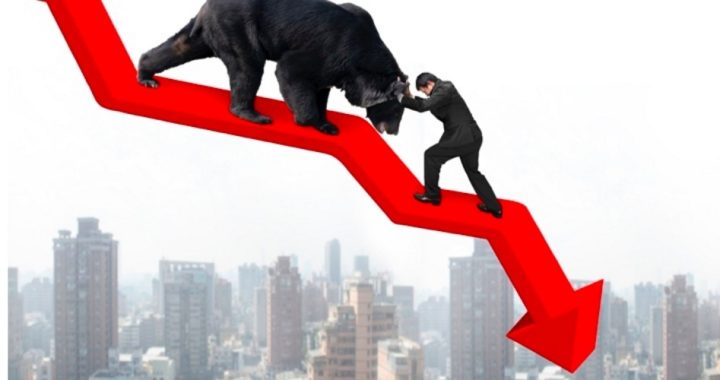
Last Friday, the Commerce Department released its initial estimate of U.S. economic growth for the fourth quarter of 2015, and the news was grim for the economy. Gross domestic product increased by a scant 0.7 percent annual rate — the weakest fourth-quarter output since 2012.
Other than not dipping into negative territory, there are few economic silver linings at the moment. Interest rates are moving upward for the first time in a decade, while the Dow Jones moves in the opposite direction. Official U3 unemployment (more on that later) is already below the Federal Reserve’s traditional “normal” range of 5.2 to 6 percent and poised to rise, especially if growth continues to sputter. Not to mention the trillions of dollars of Federal Reserve stimulus sloshing around the money supply, threatening to spark a massive inflationary cycle.
Let’s take a closer look at the most nagging immediate concern: persistently weak GDP growth.
GDP Growth Has Trended Downward for a Generation
Once upon a time, the U.S. economy was the envy of the world. Generally free from heavy-handed intervention by the Federal Reserve, cycles were shorter and down periods tended not to linger (the Great Depression notwithstanding). Meanwhile, periods of high activity were impressive: Growth spiked to a record 16.9 percent in the first quarter of 1950 and reached 7.3 percent as recently as 1984. Overall economic growth averaged a solid 3.2 percent from 1947 to 2015.
However, growth has been highly unimpressive since the turn of the century. Over the past 15 years, the rate has been an average of merely 1.9 percent per year. What’s going on?
The Forgotten Lessons of Ronald Reagan’s Presidency
Although the socioeconomic factors were far different from today, the U.S. economy suffered a similar malaise between 1970 and 1982. During that time, economic growth averaged just 2.5 percent, slightly above what we’ve seen over the past 15 years. To make matters worse, inflation raged nearly out of control and interest rates soared.
Ronald Reagan took office in 1981, a few months before the second half of the infamous “double dip” recession began. To combat the severe economic problems the country faced, Reagan famously adopted economist Arthur Laffer’s supply-side economic principles. Under that approach, top-end tax rates were to be reduced in order to spur economic growth and therefore an increase in overall tax revenues.
Robert P. Murphy, who worked for Laffer from 2006-07, explained:
If people respond to incentives — as they always do — then changes in the tax rate and tax revenues may be quite different, and can even go in opposite directions. For example, when it comes to the personal income tax, did the Reagan administration “cut taxes”? Well, tax rates certainly fell sharply: the top personal income tax rate went from 70 percent in 1980 down to 28 percent in 1988. However, during the Reagan years, tax receipts went up — from $599 billion in fiscal year 1981 to $991 billion in FY 1989 (in historical dollars), an annualized growth rate of 6.5 percent.
Taxation is certainly a large part of the story, but there are five other factors also worthy of mention.
Regulation Is Stifling Growth
As Clinton Alexander wrote in The New American, the Federal Register in 2015 was a bloated 81,611 pages long, a new record. He pointed out that the growth in executive orders and memoranda constitutes “an astounding volume of regulatory madness to foist on the citizenry.”
Regulatory overreach stifles risk-taking and entrepreneurship — two key drivers of the economy.
Federal Reserve Intervention
Sir Isaac Newton famously coined the phrase, “What goes up must come down,” and never a truer sentence has been spoken than when describing the Fed’s behavior over the past 15 years.
Between 1990 and 2000, the money supply increased 44 percent, or about 4 percent annually — roughly the pace of GDP growth. Since 2000, the money supply has soared 167.4 percent, averaging more than 10 percent per year. Meanwhile, growth has been cut in half.
The Fed’s intervention may have forestalled a deeper recession or possibly even a depression, but sluggish growth and the specter of inflation will be the legacy of its actions.
Manufacturing Jobs Are Disappearing
In January, 2005, U.S. manufacturing jobs numbered nearly 14.3 million and held steady for most of the next two years. The Great Recession slashed nearly three million people out of the sector, with less than one million returning since 2010.
Although there has been a recovery in total employment, the shift of approximately two million from manufacturing to lower-paying service sector jobs has depressed consumer spending.
The U.S. Is Losing the Currency Wars
China and numerous other countries around the world have devalued and otherwise manipulated their currencies as compared to the dollar. The reason for the currency wars is simple: if the dollar is strong in relation to another country’s currency, U.S. exports become more expensive on the world market. Conversely, the other country’s goods become cheaper.
The net effect is a damper on exports, which shaves percentages points off GDP growth.
The Labor Force Participation Rate Is Battering Consumer Spending
As mentioned early in this piece, the official U3 unemployment rate now sits at five percent and is closing in on the traditional full-employment definition of between three and four percent. However, the published unemployment rate is a myth, as the labor force participation rate is falling precipitously.
In just the last five years alone, the labor force participation rate has dropped from 64.9 percent to 62.6 percent and shows no signs of turning around. With 157.8 million people currently in the labor force, a decline of 2.3 percent means 3.6 million fewer people are drawing paychecks. Until America gets back to work, growth will remain restrained.
Ronald Reagan once said, “Government does not solve problems; it subsidizes them.” Reducing the growth, scope, and intervention of the federal government would go a long way toward the free markets correcting themselves. This in turn would help the economy heal itself after 15 years of lingering malaise. During Reagan’s presidency, the actual size of the federal budget continued to increase, but the rate of increase was reduced.
There are clearly a myriad of economic challenges within the economy in urgent need of solutions, but as Reagan also said, “There are no great limits to growth, because there are no limits of human intelligence, imagination and wonder.”



